Mild-mannered reporters by day, Greg Phillips and Nick Duke share an intense love of comic books that has made them the Hard-Traveling Fanboys. Over the course of their travels through comicdom, they have encountered numerous stories via the wonder of trade paperbacks and graphic novels. Once a month, Nick and Greg will review one of those collections in The Longbook Hunters.
Nick: Welcome back, loyal readers, to the subsection of the Internet occupied by yours truly, the Hard-Traveling Fanboys. It’s the third Friday of the month, which can only mean one thing. That’s right, it’s time to dig into our longboxes once again and bring you a very special review of something known as a trade paperback.
Greg: Up until mid-2011, one of DC Comics’ calling cards was the concept of the legacy character. While DC may not have invented the idea, it certainly embraced the notion that some superheroes (and villains) can age and, eventually, pass their mantle onto a younger generation. Sometimes, the attempts didn’t work (Aquaman, Hourman and Wonder Woman being decent examples). But more often than not, DC committed to telling stories through new eyes while remaining respectful and even nostalgic about its past.

And when it comes to both nostalgia and legacy characters, it’s hard to find a more distinctly DC concept than the Justice Society of America, a team dating in name back to the 1940s and the onset of the Golden Age of superheroes. These characters — the likes of Green Lantern, the Flash, Sandman, Wonder Woman and plenty of others — formed the lynchpin of DC’s in-canon history throughout the Golden, Silver and Bronze ages, providing a link to the past that helped keep the oldest stories within the medium alive.
By the mid-1990s, though, nostalgia had lost its relevance. Young comic readers (of which I was one at the time) weren’t interested in reading adventures from the 1940s, especially with gun-toting futuristic cyborgs in seemingly every comic. For a while, in the aftermath of the Zero Hour event, the old heroes of the Justice Society went away for the most part. One writer, though, kept the concepts alive through his stellar Starman series (which we reviewed just last year in this column).
And in 1999, Robinson hooked up with comics newcomer and fellow writer David S. Goyer to bring the Justice Society back into a fully realized modern context. Rather than reboot the characters from scratch, Goyer and Robinson set about mixing younger, fresher characters with the old batch of senior-aged superheroes and making them vital to the DC Universe in a way they hadn’t been in decades.
The beginning of that attempt, which would turn into a deade-plus-running ongoing series, was JSA. And with that breathless history lesson out of the way, we’ll be taking a look at JSA Vol. 1: Justice Be Done, by Robinson, Goyer and Stephen Sadowski (among other artists).
 Nick: Yes, as Greg said, this volume was penned by Robinson and Goyer, who also had a hand in numerous comic book films, including a little Batman trilogy you may or may not have heard of.
Nick: Yes, as Greg said, this volume was penned by Robinson and Goyer, who also had a hand in numerous comic book films, including a little Batman trilogy you may or may not have heard of.
And while this book seeks to reintroduce the JSA, this ain’t exactly your Grandpa’s Justice Society of America. Sandman, Starman, Star-Spangled Kid, Black Canary, Hawkgirl and Dr. Fate all appear here in updated forms, rather than their Golden Age counterparts. The 80s character Nuklon has become the Atom Smasher in a nod to the original Atom and Alan Scott, the Golden Age Green Lantern, has taken on the moniker Sentinel.
That all may sound like a lot to keep up with, and to be honest, it kind of is. I’m largely unfamiliar with the Golden Age outside of Scott, Jay Garrick and the Golden Age exploits of DC’s trinity of Batman, Superman and Wonder Woman, so to have characters and concepts like Sandman and Sandy the Golden Boy thrown at me in the first few pages was tough. Truth be told, the book faces a tall order in trying to introduce an entire team of characters to new readers in just one volume. At times, the exposition is laid on a bit thick, but overall, I feel like it does a good enough job of giving you a reason to care about each character introduced.
Greg: Yeah, the trade starts out with mini-biographies of some of the major players, which are helpful in some ways but served to raise more questions than answers for me. Even as someone steeped in DC lore, the detailed (and often convoluted, thanks to years of retcons) histories of some of these characters were as intriguing as they were confusing. For instance, learning that (in the continuity of the late ’90s anyway) Wonder Woman’s mother, Hippolyta, had taken on the same mantle and worked with the Justice Society in years past was a shocker.
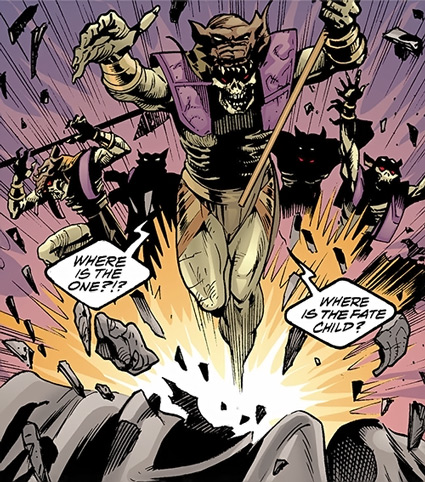
However, to echo Nick’s thoughts, despite the jungle of continuity, the creative team did a fairly good job of giving us entry points on each of the major characters. Taking a similar approach to the beginning of Robinson’s Starman series, this book opens with a murder mystery, including a suspenseful death scene for a major Golden Age player.
This opening was essential to keeping my interest, because it would’ve been easy to get lost in the maze of characters. Nick, how long did it take you to get your bearings, for lack of a better word?
Nick: It took a while. The trade collects five issues plus parts of a Secret Files, and I’d say it took me until around the second issue to really figure out who was who and how they all related to each other. That isn’t to say that I wasn’t interested prior to that. The murder mystery you referenced had me intrigued from the getgo, even if it did take a while for me to fully understand its importance.
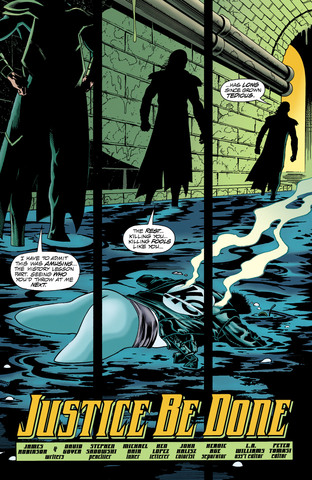
It’s no shock, then, that the characters I took to the most were the ones who hadn’t been around as long. Hourman, Starman, Hawkgirl and Sand were all characters I almost instantly liked and wanted to know more about. Greg, did you gravitate more toward the old or newer characters?
Greg: Perhaps owing to my own slavish devotion to the legacies themselves, I found myself drawn at first to the old guard — Wildcat, Sentinel and Flash in particular. I’ve always been a fan of aged boxer Ted “Wildcat” Grant, and my love for the original Green Lantern and Flash have only increased over the years thanks to their presence in some of my favorite stories (“Hush” and “Blitz,” to name two).

Yet by the middle of this volume, I was more interested in finding out about the characters you mentioned and Star-Spangled Kid, who would later be renamed Stargirl and become one of my favorite DC characters. Starman, obviously, I had knowledge of prior to this thanks to his solo series. He provides much of the humor throughout the book, but the revelations to me were Hourman and Hawkgirl, who I knew nothing about (in these iterations) prior to this story. As we’ve likely discussed before, the entire Hawkman side of the DC universe is historically a convoluted mess, so to be able to start at the ground floor with a brand new character (though one with a legacy connection to the original incarnation of the character) was a nice changeup.
One of the things that surprised me is just how much freedom Goyer and Robinson had with the fates, no pun intended, of these characters. We see the contemporary ’90s version of Doctor Fate, the original Sandman, Kid Eternity and others bite the dust (again, no pun intended … I promise) fairly early on, and by the end we have a brand new Doctor Fate and a new status quo for everyone involved.
Nick: Indeed. Which brings us to the actual plot of the story. A child has been born somewhere on Earth, and that child is destined to become the new Dr. Fate. The once and future JSA members find out about this after the death of Wesley Dodds, the original Sandman, and set out to stop Mordru, a supernatural dark lord, from finding the child and absorbing Fate’s powers.
Along the way, we get the classic JSA and JLA story structure of having the heroes split off into two- or three-man teams to search the globe. In the end, the JSA faces off with Mordru at the Tower of Fate, which is of course located in another dimension. Again, it sounds like a lot to take in, but it doesn’t read nearly as confusing in execution as it does in synopsis.

Greg: In fact, it’s pretty much Superhero Team Comics 101 — split the team up into smaller groups to establish personality, powers and relationships, then bring ’em together to fight the Big Bad. In this case, we also get Sorcery Comics 101, with a mystical villain in Mordru who battles the team on his terms, in the alternate dimension of the Tower of Fate. It’s executed well throughout, despite some of aforementioned overuse of exposition, and I found myself enthralled by the team’s battle with Mordru, who I was convinced I’d find dull before the big battle.
See, I’ve never been a big fan of magic-based comics characters. In recent years, books like Bill Willingham’s Day of Vengeance have started to change my mind on that, but I’ve never found villains like Felix Faust and anybody named Baron to be terribly interesting. Different strokes, as they say. Yet Mordru is established as enough of a big deal and enough of a scumbag early on that it’s genuinely exciting when the JSA finally gets to confront him, though the battle goes poorly for them at first.
How did Mordru work as a threat for you, Nick, and what did you think of the climactic battle, which plays out through the last two chapters of the main story?
Nick: Robinson and Goyer certainly did a good job of making it clear that Mordru was not just a threat to the Society, but perhaps better than even all of them combined. He handles the JSA easily for most of the battle, only to have Dr. Fate’s arrival turn the tables, That battle between Fate and Mordru certainly delivers, as the two throw unique spell after unique spell at each other. It gives the artists tons of material to really play with, and when combined with the alternate dimension setting it makes for some really fun superhero pages.

And because I’m a sucker for Dr. Fate and the general concept of that character, I loved him being the one to take down Mordru in the end. Fate is the epitome of a mystical badass, no matter who wears the helm, and this new Fate is no exception.

Greg: Indeed, and I remain thankful that Robinson and Goyer spared me the origins of the ’90s Fate, who appeared to be the living embodiment of ’90s comics (and I LIKE ’90s comics!).
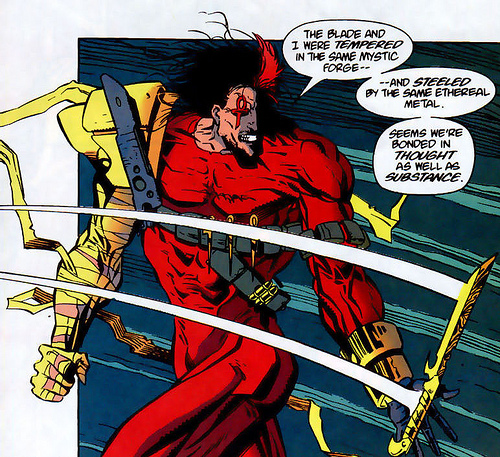
(Editor’s note to fans of the ’90s Fate: I don’t care to learn about him.)
(Editor’s note part 2: Just kidding. Feel free to point me in the direction of any good stories featuring him.)
In any event, I have to agree. Doc Fate has always been one of the coolest DC characters, and Justice Be Done does a great job giving us a reason to care about this new iteration before the mantle is thrust upon him.
I think that’s one of the keys to successful legacy characters. Readers must be given compelling reasons to care about this new person before being expected to accept them as replacements for icons, even minor icons like the Golden Age Atom. In the cases of, for instance, Conner Hawke, Jason Todd and Kyle Rayner, longtime fans felt isolated in many cases because these characters were introduced with little backstory or fanfare and immediately placed into the shoes of some of the greatest characters in comics. Contrarily, fans accepted Jack Knight due to his compelling journey into becoming Starman. Nobody rejects Carol Danvers as Captain Marvel because she’s a character with years of compelling backstory and goodwill from the fans. In general, the successful legacy characters share those same traits.
All rules have exceptions, of course. Ben Reilly had been built up for quite a while before becoming Spider-Man, and most would consider that tenure a failure (though I am not among them). Still, Robinson and Goyer thankfully imbue these characters with enough individuality and personality to gain readers’ respect and interest that we don’t bat an eye at them assuming lofty roles. The new Dr. Fate, in particular, more than earns his spot at the Tower.
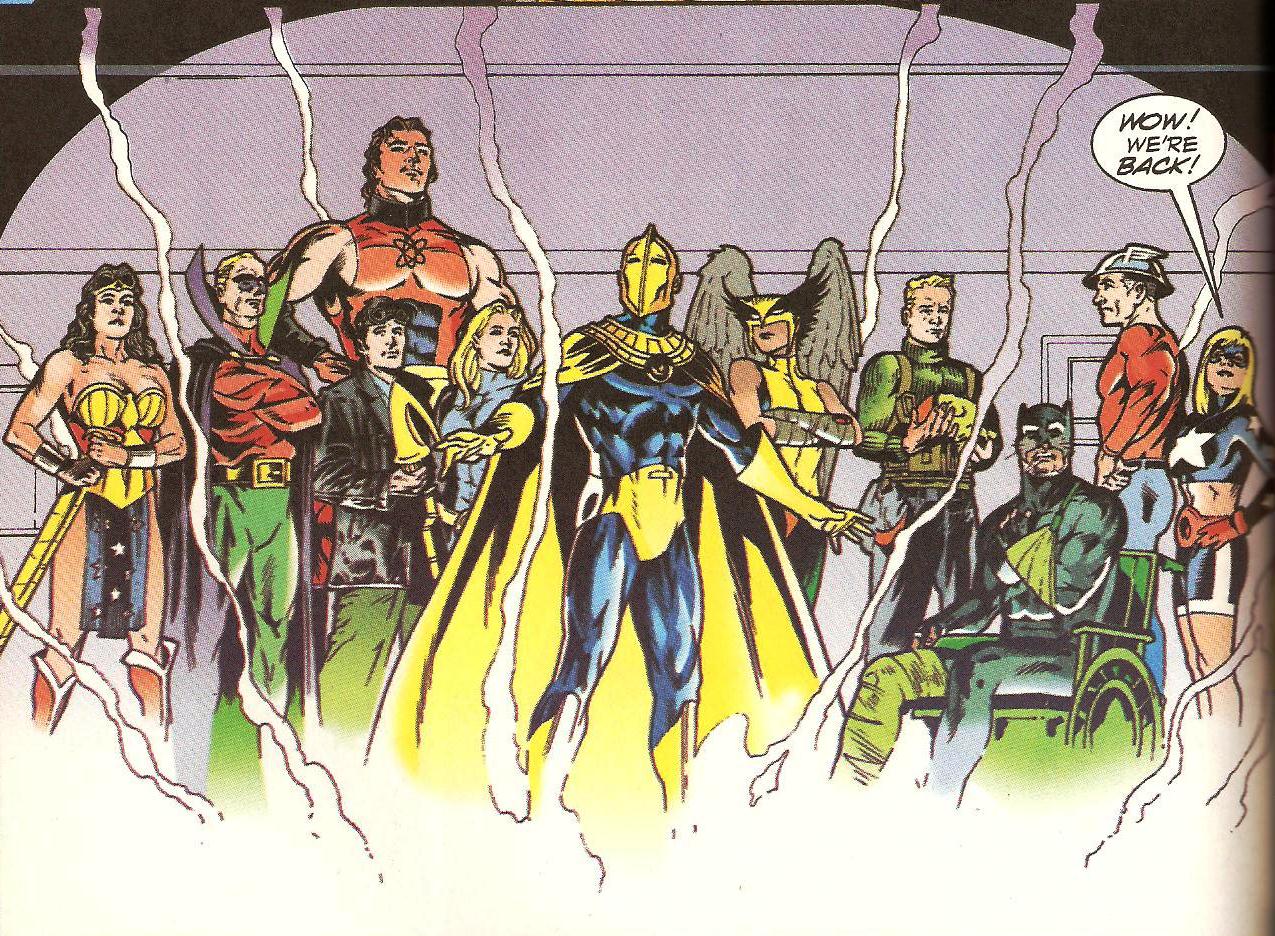
Nick: Couldn’t agree more. Well, I think we’ve about covered it all. Greg, your recommendation — own, read or pass?
Me, I say it’s certainly worth a read. I think it’s a little heavy on the setup and exposition to be a must-own, but comic book fans, especially those who have a bit of nostalgia for simpler times, should go out of their way to check this one out.
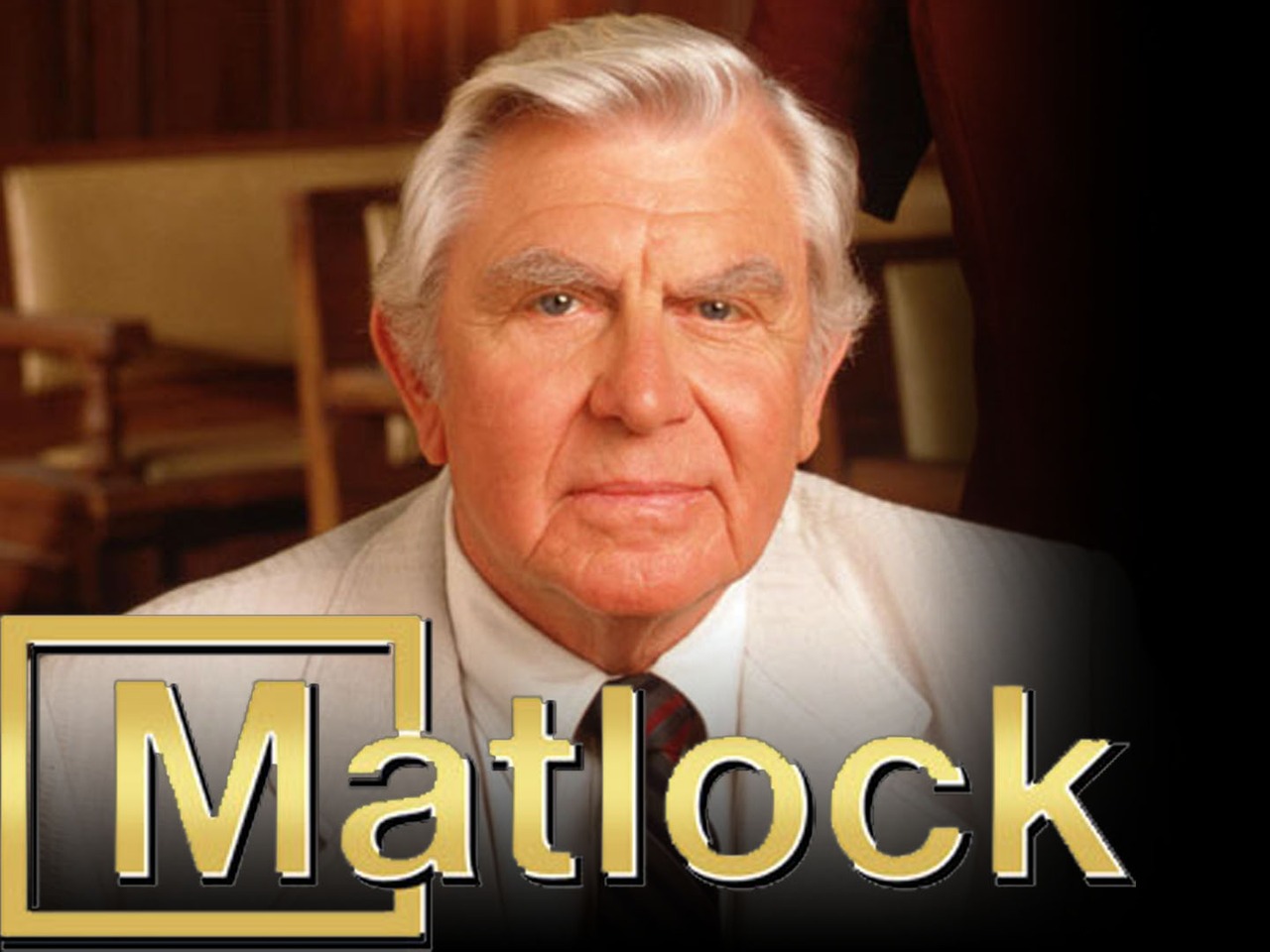
Greg: For those already invested in the rich tapestry of the DC Universe, I’d say go ahead and buy this one, especially if you’re looking to delve further into the critically acclaimed series, which would soon lose Robinson but gain Hard-Traveling Fanboys fave Geoff Johns as co-writer with Goyer.
For more casual fans, I’d say it’s strictly a read-first book. If you like what you see, it’s a good addition to your collection, as it’s a nice glimpse into two interesting periods in superhero history — the Golden Age and the turn of the new millennium. However, if you’re that interested, a better value might be the recently released first volume of the JSA Omnibus, which collects this and a whole lot more. You can check that out by clicking on the Amazon link at the side of this page.

Nick: Well, that about does it for us this week. Come back next week, as for the first time in months, the Hard-Traveling Fanboys discuss all the comic book news that’s fit to print in the long-awaited return of The Rundown!
Greg: As always, we welcome your feedback via email (GregP@placetobenation.com and NickD@placetobenation.com), through Twitter (@gphillips8652 and @nickduke87) or through the PTBN Facebook page.